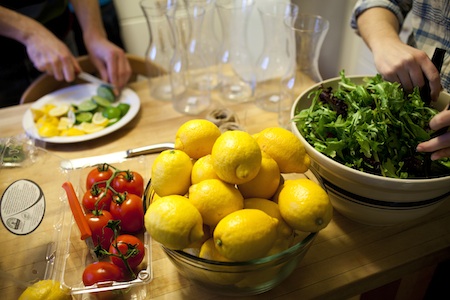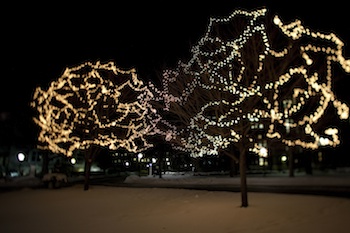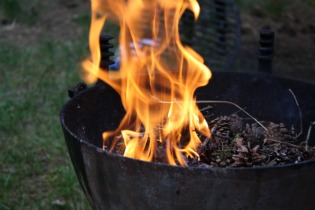Recently in SAGE Advice Category
Not every kilowatt-hour is made equal. You may see your electric bill and think, “this is the amount of electricity I used, multiplied by the price, and with a few taxes added.” Actually, the true cost of electricity is not that simple. The amount of power you use is very important, but when is also important. Running an appliance at 1 pm is not the same as running it at 9pm. The reason for this is due to the way the power grid works.
- The power being used and the power being generated must be the same.
- Most forms of power generation require time to start up.
- The demand for electricity changes over the course of the year, as well as over the course of the day.

From the above issues, we may notice a few problems. You can’t just produce power thinking it will just be used eventually. At the same time, most of our power does not come from sources you can simply switch on and off. At one extreme, nuclear power is not really turned off, ever. Coal may take approximately 8 hours to fully turn on. Many renewables can’t be used all the time; it might me a cloudy day and the wind may not be blowing.
You can imagine that there is a great deal more electricity used on a summer day than on a winter night. So what do you do? You need to generate extra power for the middle of the day, known as peak demand, when people are working and AC units are on full blast.
So the solution entails much more expensive fuels. The tip of the peak demand for power is generated by burning petroleum fuels. It is a small amount of power but a disproportionally large portion of the emissions related to generating electricity. This means that we need to start thinking about when we use power. Running the washer at 1 PM or 9 PM may use the same amount of power, but the emissions associated are different.

So what can you do?
We won’t propose that you turn the AC off and feel very uncomfortable on the hottest day of the year, but try doing your laundry a little later, maybe run the dishwasher over night, or perhaps turn off your surge protectors. Simply start thinking about which activities can be moved outside the 9AM to 5PM time slot—get creative!

When first arriving in India for study abroad in Fall 2010, students met with the program directors to discuss living at the hotel. At this meeting, a simple question was asked: “Does the hotel recycle?” The room burst into laughter. The answer, in case any naysayers are wondering, was yes—but there was much more to the answer than that. Indians define recycling in a completely different way than we Americans do—they repurpose, recreate, reuse, and upcycle. At our hotel, cleaning fluids were kept in reused water bottles (compared to the U.S. where cleaning fluids are purchased in bottles that are used once and then disposed of) and surplus food from the restaurant was sent home with the employees at the end of the day. In a country of ten billion, where trash pickup is infrequent, reusing becomes the rule, not the exception. I think we have a lot to learn from how Indians perceive trash and how they seem to always think of ways to repurpose things Americans would easily throw away. Here are some lessons from my inner-Indian:
- Check yourself before your wreck yourself/the environment: Before you buy something, consider whether you really need it. Also, think about alternative products—instead of purchasing disposable plastic sandwich bags, invest in a reusable sandwich bag, such as a snack taxi.
Think ahead:
- As you dash out the door in the morning, grab your reusable coffee mug. Many java shops even offer discounts to those who BYOMug Over 16 billion single-use cups are tossed in the trash each year*. The process to make this massive amount of cups wastes enough water to fill 6,000 Olympic-sized swimming pools.
- Stay hydrated by bringing your reusable water bottle with you, everywhere. Not only will you decrease your carbon footprint, you’ll also save a large chunk of change considering that gallon-per-gallon, bottled water is more expensive than gasoline.
- Keep reusable bags in your purse or in your car so they travel with you. Use them if you drop by the grocery or need to transport your Tupperware.
Think outside the box, literally: Take packaging into consideration when you purchase something and when you’re unpacking something new. Keep packaging materials for use later down the line or use things you already have to package items. For gifts, invest in some reusable bags. The website even allows you to track where these bags travel!
- Repurpose: Before you throw something away, or even recycle it, consider its possibilities! In my apartment, we have started a quirky compilation of glass jars as an addition to our drinking glass collection. I also have a couple of plastic truffle trays I use to sort my earrings. Before you chuck it, check it. There’s potential in almost everything!
In the end, it’s best to consider if what you’re tossing in the trash really is trash. Help celebrate the Earth by taking a second to tap into your creative side before throwing something away, because it never really goes “away.”
*source here

Have you ever picked up a bottle of household cleaner, such as Fantastic, and tried to read through the list of ingredients? Chances are, you haven’t. If you have, however, you’ll know that the ingredients list is chalked full of chemicals, chemicals, and more chemicals—most of which have extremely long and rather unpronounceable names. While some feel that brand-name chemicals are the most efficacious, you can in fact make a greener choice without sacrificing quality. Cleaning supplies laden with chemicals end up in landfills and sewers—leaking into our water supply and eventually entering into our bodies, where they can act as carcinogens. When you start to plan your spring cleaning, consider turning to these simple, homemade recipes and tricks for a space filled with natural brilliance instead of strong chemicals.
- Make your own cleaning products: it’s easier and cheaper than you think! An investment in a couple of essential oils can lead to an entire pantry filled with eco-friendly, effective cleaning solutions. Here’s one to try for an herbal disinfectant: combine and shake well 2 cups of hot water, 10 drops of thyme essential oil, and ¼ cup washing soda. And presto—use as a spray on any germy surface to disinfect.
- Get creative: Think of ways to reuse items you’d typically throw away. Maybe take an empty store-bought soap dispenser to use for your own homemade soap or use cardboard boxes to organize items in your pantry.
- Make a resolution: If you designate a day each week for cleaning certain spaces in your apartment or dorm, you can avoid grime buildup. This way cleaning will be easier and you wont be tempted to turn to chemical-laden products to clean your space.
- Use what’s around: Did you know there are 17 ways to clean with lemons? Other common household items can be equally as useful if you just think outside the chemical bottles.
For more tips, recipes, and greener cleaners, click here.
Photo source here.

Hey there, love birds. Looking to make a big impression on the epic day for romance? Well have we got ideas for you! We’ve compiled a list of all the Valentine’s Day must-haves that promises to impress your partner and leave less of a dent in both your bank account and the planet.
- Flowers: Go with sustainable, organic flowers- local if possible. Give Organic Bouquet a try!
- Chocolate: Boxed chocolates are impersonal and so 10 years ago. If you want to impress your partner or guests at a Valentine’s party, make truffles! Try this recipe, which you can customize with four different options for flavoring and three options for coating.
- Dinner: Check out one of Chicago’s sustainable restaurants—try up-scale authentic Mexican dining at Topolobambo or try Uncommon Ground, America’s greenest restaurant. For an even more memorable evening, make a fondue dinner for an intimate evening at home with your loved one or a group of close friends.
- Inside the wrapping: Disclaimer—diamonds aren’t always a girl’s best friend. Instead of spending a fortune on that pair of earrings she may not like, buy tickets for a show you know she loves or go ice-skating in Millennium Park. Get tickets to Come Fly Away, featuring the romantic crooning of Sinatra, which is playing after Valentine’s Day in Chicago for an enchanting pre- or post-dinner surprise.
- The card that says it all: There is nothing like the look of fuzzy bears for Valentines day- and you can help ensure future generations will see them. NRDC is featuring a Valentine’s Collection of cards, which display cute animal pics to express how “otterly in love” you feel.
- Tying the knot: If you’re planning on popping the question this year, try something innovative and make your own fortune cookie.
We wish you and yours the best this Valentines Day. Email Christy with photos of your sustainable V-day by February 21st and enter for the chance to win a box of homemade truffles. We will also post the winning photos on Dirt. Help us show that every kiss doesn’t necessarily begin with Kay.
 Wondering which fresh fruits and veggies are available when winter strikes and snow covers the ground? The frigid months may make it seem like produce can’t be cultivated, however, there are numerous seasonal options to choose from during the winter months. While the seasonal fruits and vegetables in Illinois and the Midwest are limited during the months of December, January and February, there are regions that grow foods that thrive in chillier weather. Buying seasonally ensures the freshest produce and encourages you to try new foods and experiment with recipes!
Wondering which fresh fruits and veggies are available when winter strikes and snow covers the ground? The frigid months may make it seem like produce can’t be cultivated, however, there are numerous seasonal options to choose from during the winter months. While the seasonal fruits and vegetables in Illinois and the Midwest are limited during the months of December, January and February, there are regions that grow foods that thrive in chillier weather. Buying seasonally ensures the freshest produce and encourages you to try new foods and experiment with recipes!
Below is a list of winter veggies and fruits, each of which are linked to simple and creative ideas for how to incorporate these foods into your diet.
Brussels Sprouts should be firm and compact, with bright green heads. These veggies are a part of the cabbage family and are high in vitamin C.
Collard Greens come in bunches and should have dark green leaves, with no yellowing. These greens are a good source of calcium and fiber.
Dates should be shiny, uniformly colored and intact, and can be stored in an airtight container in the fridge for up to a year. Dates contain antioxidants and are high in potassium and fiber.
Leeks should be firm, crisp stalks with as much white and light green sections as possible. Leeks are a member of the onion family, but have a sweeter, subtler flavor and can be eaten raw or cooked.
Persimmons are smooth, brightly colored, plump, glossy and well rounded. This fruit originates from Asia and is an excellent source of fiber.
Sweet Potatoes should be firm, small-to-medium sized with smooth skin. A member of the morning glory family, sweet potatoes are high in vitamins A and C.
Turnips come in all shapes and colors; small to medium ones are sweetest. They may be eaten raw or cooked and are a good source of vitamin C.
Update: Ready to recycle your holiday tree? Participating sites across Chicagoland will be open January 7-January 23.
Jingle bells are ringing and somewhere there’s definitely a choir singing about snowmen or famous reindeer or mistletoe or everyone’s favorite jolly Saint from the North Pole. Yes, now that we have successfully gorged on turkey and stuffing, it’s time to bring in the “most wonderful time of the year.” But as you hang the stockings by the chimney or spin the dradle, consider making this holiday season a green one. Try taking our advice between singing carols and we think your festivities will go down in history.

- Hosting a holiday party? Whether you’re planning on ringing in 2012 or simply gathering a group to light the menorah, be sure to be mindful of the setting. Incorporate local, organic vegetables into your spread and think about going for chicken or turkey over beef. Poultry options require 85% less water and 75% less fossil fuels* than beef production. Also, remember to go with reusable silverware and plates—your guests deserve the best (and so does the environment)!
- Hitting the road for the holidays? Before you pack your bags and leave the office, dorm, or your apartment behind, be sure to power down your electronics. Take part in the University’s Power Down by ensuring your lights and computers are off for the holiday season.
- For those who love to play Santa, think outside the box—literally. Think about buying concert tickets or gift cards to sustainable restaurants (for you Chicagoans, check out this list!), or other gifts that require little or no packaging. If you’re out of ideas or married to the idea of a tangible gift, consider looking into businesses that sell clever gifts made from repurposed materials.
- Dress your home and your tree in the very best: deck your halls with LED lights, which use 95% less energy than conventional lighting options. You can also save $50 in electricity costs this season if you make the switch.
- When the eggnog is gone and the ornaments come off your tree, recycle it! Don’t throw it into the fireplace, as burning the bark can contribute to creosote (a toxic preservative) buildup. Instead, recycle the tree for free by bringing it to a Chicagoland park. More details will be announced by the City of Chicago later this month.
Perhaps I am sentimental or old-fashioned, maybe I sound like your grandfather, but remember that ‘tis the season to be jolly—not the season of presents, epic deals, or overindulging on latkes. The holiday season can be an exceptional part of the year, a time to spend with those we value most in our lives and not the stuff we quickly tire of and hoard. So I’m offering this simple thought, for kids from one to ninety-two—as you sip hot chocolate and watch the frightful weather (from indoors, hopefully), remember that this is a time to be merry with the people we love. We wish you and yours a delightful holiday season.
* Rogers, Elizabeth. Shift Your Habit: Save Money, Save the Planet. New York: Three Rivers Press, 2010.
Too cold? See last year’s November SAGE advice.

Okay, fine, maybe it’s not winter quite yet, but soon enough (as much as I hate to admit it), winter will be upon us. Each year, when the low temps strike and we start piling on the layers, I sometimes find myself getting a little too warm in some of our campus buildings—sometimes sweating in my sweater. While the weather outside might be frightful, inside it’s not always so delightful. But before you crack open a window to cool down (or plug in a space heater to warm up), follow these quick tips:
- When you find yourself just too hot to handle indoors, turn down the heat! In fact, you might even consider turning off a radiator. Whatever you do, don’t touch that air-conditioning dial! Turning on your air conditioner is not only a waste of electricity, it also fools your heating system into thinking it’s colder than it actually is, making your heating system work even harder (and resulting in higher electricity and heating bills!). In fact, if you have an air conditioner sitting in your window, take it out or cover it up (in campus buildings, contact the Work Center, see below). Window air conditioners contribute to heat loss, so wrap it up to insulate your office from the cold.
- Too warm while your professor debates the merits of Marx? Falling asleep because of the heat during your office meeting? Contact the Work Center at 773-834-1414. Facilities Services staff will assess the situation and make adjustments as needed. (If you’re in the dorms, submit a request via HouseNet.)
- Get informed! For a more extensive list of winter do’s and dont’s, please see last year’s SAGE Advice on staying warm in our cold Chicago winters.
They say this winter is going to be one of the worst on record—but we all know that even when it’s up to your knees out there, you won’t turn into an ice sculpture inside. Bundle up and stay warm- inside and out.

As these past few weeks have made obvious to most Chicago residents, we have finally joined the world in celebrating everyone’s favorite season: summer. Yes, it’s time to stow away that down coat and start donning that pair of Ray Bans you’ve been keeping in the dark all winter. And what better ways to celebrate 80 degree temps than with long days on the beach, and, of course, one of America’s favorite culinary traditions—grilling.
But before you fire up the grill or stock up on propane and beef, here are some important things to consider:
- The Main Dish: America runs on meat, especially when we think about putting things on the grill. One way to lessen your carbon footprint is to increase the amount of veggies you grill. Remember? Corn on the cobb, peppers, eggplant, zucchini, pineapple, asparagus, onions, mushrooms, tomatoes, and potatoes are all easy additions for a barbeque feast. Also consider serving a salad filled with locally grown vegetables and fruit. While we all know that beef consumption is not quite environmentally friendly, you can lessen your footprint by buying grass-fed beef—or substitute extra firm tofu in any recipe that calls for meat.
- The Act of Grilling: As you stand over that smoking grill, try closing the hood. This will increase the efficiency of the grill and allow the food within to cook more evenly.
- Dessert: While finishing off a barbeque with an apple pie a la mode might seem like a brilliant (and traditional) plan, consider making a blueberry cobbler or having grilled peaches, apples, or pears a la mode instead. Ovens are so energy inefficient that a residential oven design has yet to gain the Energy Star label. So, for a real treat, throw a fruit cobbler in a foil pan on the barbeque as coals are burning out—as far as the environment is concerned, that’s free energy!.
- Serving the finished product: Sure, those summer-themed plastic plates with their festive colors and bright designs might be tempting, but thinking about them sitting in a landfill isn’t so exciting. So instead of buying plastic ware, save some money and the environment by providing barbeque-goers with reusable silverware and plates. Not only will these options help keep your costs down; they will also keep your grilled goods warmer for longer. If lugging your grandmother’s finest porcelain out to the park doesn’t sound appealing, try buying Reusable Preserve tableware. This plastic ware is sturdy, lightweight, and dishwasher safe so you can reuse them at your next party or backyard gathering.
- Choosing a Grill: If you’re the market for a new grill, deciding between propane and charcoal can be a daunting task. Using charcoal briquettes might be the most sustainable option considering that they’re made from waste products, but the choice isn’t so clear-cut. For more about the pro’s and con’s, click here.
Whatever you’re throwing on the barbie this summer, we wish you and yours a delicious and safe celebration of food, sun, and all other excellent things that announce the presence of summer.
Palmer, Brian. “Fire Up the Grill, Not the Atmosphere.” Editorial. New York Times. 29 June 2011. Web. http://www.nytimes.com/2011/06/30/opinion/30palmer.html?_r=1. Silver, Rebecca. “How to Go Green: Barbecues.” TreeHugger. 19 Feb. 2007. Web. 07 July 2011. http://www.treehugger.com/files/2007/02/how-to-go-green-barbecues.php.
Photo source: http://en.wikipedia.org/wiki/File:Preparinggrillforgrilling,grillwithflamesandcones.jpg
Unfortunately, there has been an increase in ‘involuntary bicycle recycling’ (i.e. bicycle theft) this spring in and around the University. Several recycles bicycles are among those that have been ‘involuntarily recycled.’ In order to ensure that this does not happen to your bicycle, we’d like to remind you to be sure to properly lock it at all times.
What does a properly locked bicycle look like? Please see below for detailed locking procedures.
Proper locking procedure for standard bicycle: When locking the bike with the u-lock, include the frame and the front wheel and attach to the bike rack. Give the bike lock or chain a tug after locking, to ensure that it is secure.

Proper locking procedure for a tandem bicycle: The tandem bike is locked using two u-locks. Use the first u-lock to secure either the front or back wheel to the frame of the bike. Use the second u-lock to secure the remaining wheel to the frame of the bike and the bike rack. Give each bike lock a tug after locking, to ensure that it is secure.
Thanks, and safe cycling!
Picture courtesy of CDOT
It’s finally spring! The weather is improving, you can put your winter coat optimistically out of rotation, and farmers markets all over the city are beginning to sprout up. Farms have different offerings in the spring than they do in the summer, so here’s a brief list of fresh produce that’s available in the spring:
Asparagus: The tender, pencil sized spears of asparagus offered early in the growing season are a joy. Try baked asparagus with balsamic butter sauce or quinoa salad with roasted asparagus and white beans!
Lettuce: Fresh, crisp lettuce makes for an excellent spring salad. Make a pear, lettuce, and feta salad for lunch this week!
Fiddlehead ferns: They look a little weird, but fiddleheads are a springtime delicacy. They’re foraged, not farmed, and only available for a few weeks in April and May. Have a hankering for Asian food? Give sautéed Korean fiddleheads a try!

Green beans: One of the few beans that can be eaten raw, their peak season is in the late spring. Try shallot-thyme peas and green beans.
Peas: Gregor Mendel was well aware of the versatility of the pea, and you should be, too! While peas are in season this spring, try corn pancakes with spicy peas or spring pea tortellini.
Mustard greens: Looking to add some zest to your springtime meal? Add some mustard greens. Grilled pork medallion with preserved lemon, mustard greens and bulger wheat is a good place to start.
Spinach: Did you know that a serving of spinach has more iron than a hamburger? Maybe that is why medieval peasants anxiously awaited the spinach crop each spring after a long winter. Try sautéed spinach with garlic and lemon for a delicious appetizer.
Here is a comprehensive list of the farmers markets in Chicago this season, along with another list focusing on those opening during May—one, Green City Market, even opens today! Happy eating!
Photo courtesy of:http://ohmygoache.wordpress.com/; accessed 4 May 2011
